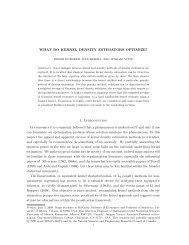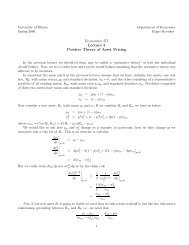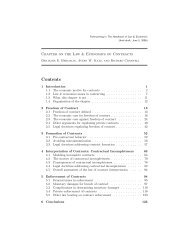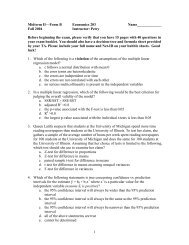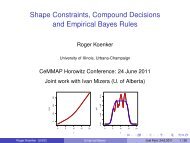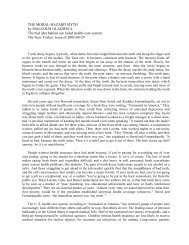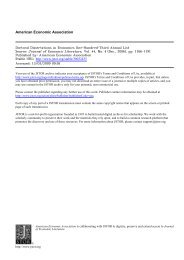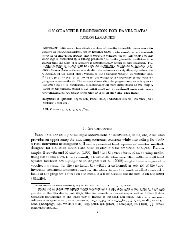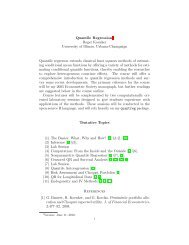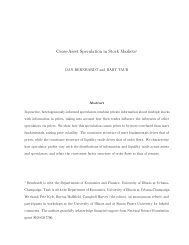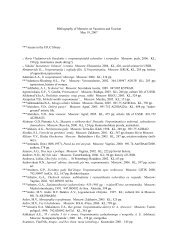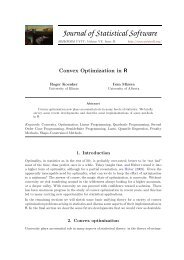1. Introduction - Econometrics at Illinois - University of Illinois at ...
1. Introduction - Econometrics at Illinois - University of Illinois at ...
1. Introduction - Econometrics at Illinois - University of Illinois at ...
You also want an ePaper? Increase the reach of your titles
YUMPU automatically turns print PDFs into web optimized ePapers that Google loves.
Roger Koenker and Zhijie Xiao 35Appendix A. Monte Carlo ResultsWe have conducted some limited Monte Carlo experiments to examine the nite sample performance<strong>of</strong> the proposed tests. In particular, we examine the eectiveness <strong>of</strong> the martingale transform<strong>at</strong>ionbased on the size and power properties <strong>of</strong> the tests. The following sample sizes wereconsidered in our experiment: n =100; 200; 300; 400; 500: These sample sizes were chosen becausethey represent the most relevant range <strong>of</strong> sample sizes in empirical analyses.First <strong>of</strong> all, to investig<strong>at</strong>e the eectiveness <strong>of</strong> the martingale transform<strong>at</strong>ion on quantile regressioninference, we examine the size and power properties <strong>of</strong> the infeasible version tests where the truedensity and score functions are used in the standardiz<strong>at</strong>ion and the martingale transform<strong>at</strong>ion. Westart with the heteroscedasticity test. The d<strong>at</strong>a were gener<strong>at</strong>ed from(A.1)y i = + x i + (x i )u i ;where x i and u i are iid N (0; 1) random vari<strong>at</strong>es and are mutually independent, =0; and =<strong>1.</strong>(x i )=0 + 1x i , 0 =<strong>1.</strong> We examined the empirical rejection r<strong>at</strong>es <strong>of</strong> the test for dierentchoices <strong>of</strong> sample sizes and 1 values, <strong>at</strong> 5% level <strong>of</strong> signicance. In constructing the test, we usedthe OLS estim<strong>at</strong>or for , b and the trunc<strong>at</strong>ion parameter value = 0:05 (i.e. T =[0:05; 0:95]).Since x i is a scalar, the limiting null distribution <strong>of</strong> the test st<strong>at</strong>istic is sup0:050:95 jW ()j : The5% level critical value is 2.14. For the choices <strong>of</strong> the heteroscedasticity parameter 1; we consider1 =0; 0:1; 0:2; 0:3; 0:5; 1; 2; 5: When 1 =0; the model is homoscedastic and the rejection r<strong>at</strong>esgive the empirical sizes. When 1 6= 0; the model is heteroscedastic and the rejection r<strong>at</strong>es deliverthe empirical powers. Table 1 reports the empirical rejection r<strong>at</strong>es for dierent values <strong>of</strong> 1 and n:Other values <strong>of</strong> the trunc<strong>at</strong>ion parameter were also tried and quantit<strong>at</strong>ively similar results wereobtained. These Monte Carlo results indic<strong>at</strong>e th<strong>at</strong>, given inform<strong>at</strong>ion on the density and score, themartingale transform<strong>at</strong>ion brings pretty good size and power to the proposed testing procedure innite sample.The remaining Monte-Carlo experiments are based on the even simpler two sample model, y 1i = 1 + 1u i ;i=1; :::::;n1;(A.2)y2i = 2 + 2v i ;i=1; :::::; n2;In particular, we considered the following two sets <strong>of</strong> parameter values(A.3)(A.4)Loc<strong>at</strong>ion Shift: 1 =1;2 =0;1 = 2 =1;Loc<strong>at</strong>ion-Scale Shift: 1 =1;2 =0;1 =2;2 =1;where u i ;v i are iid N (0; 1) random vari<strong>at</strong>es. When the parameters take the rst set <strong>of</strong> values, (A.2)represents a pure loc<strong>at</strong>ion shift model. The null hypothesis <strong>of</strong> a shift model can be tested by theprocedure given in Section 4.2. When the d<strong>at</strong>a is gener<strong>at</strong>ed from the second set parameters, (A.2)is a loc<strong>at</strong>ion-scale shift model. The loc<strong>at</strong>ion-scale hypothesis can be tested by the procedure givenin Section 4.<strong>1.</strong> Table 2 reports the empirical size <strong>of</strong> these tests for dierent combin<strong>at</strong>ions <strong>of</strong> n1 andn2. We can see th<strong>at</strong> the test has good size properties in nite samples. These Monte Carlo results,together with the results on the heteroscedasticity testinTable 1, conrm the eectiveness <strong>of</strong> themartingale transform<strong>at</strong>ion in quantile regression inference.The above Monte Carlo experiments use the true density and score. It is obviously also importantto evalu<strong>at</strong>e the eect <strong>of</strong> nonparametric nuisance parameter estim<strong>at</strong>ion on the performance <strong>of</strong> theproposed tests. In our next Monte Carlo experiments, we estim<strong>at</strong>ed F ,1 (s) and'0(s) using theapproach described in the text. For the score function _g, we employ the adaptive kernel estim<strong>at</strong>or<strong>of</strong> Portnoy and Koenker (1989).The kernel estim<strong>at</strong>ion procedures for these nuisance functions are nonparametric and thereforeobviously entail choices <strong>of</strong> bandwidth values. Unsuitable bandwidth selection can produce poor



